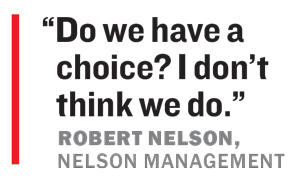Trending
Multifamily’s trillion-dollar tango
Investors face eviction moratoriums, lender anxiety as tenant debt mounts

Multifamily lenders and policymakers have taken much the same approach with evictions and mounting debt during the pandemic: Put things off and hope the rental market’s problems resolve themselves before it’s too late.
That strategy persists as vaccinations ramp up. But with a surge in Covid cases, restrictions on economic activity and evictions could continue for months. As landlords hold on, they are on the hook for more than $1 trillion in multifamily debt held by agency and bank lenders.
Tenants’ debt, too, is building — they owe $57 billion in back rent and utilities, Moody’s Analytics estimates. Yet landlords are not walking away from their assets.
That’s largely because, miraculously, rental payments haven’t fallen much throughout the pandemic. Although an industry group in December reported the largest drop in rental payments in market-rate units since April, apartments — unlike some other asset types — are still performing.
Lenders are more inclined to work with multifamily borrowers whose cash flow problems are seen as temporary, rather than hotel or luxury condo developers, whose assets may have fundamental, long-term problems.
Lenders, however, don’t have infinite patience, even if they prefer not to foreclose, said David Wright, CEO of Beverly Hills-based multifamily developer Markwood.
“The understanding between lenders and borrowers is that we want to be able to access the capital markets, and they don’t want to own real estate,” he said. “But there’s going to be a limit, at which point people are going to have to take a harder stance.”
Waiting for Godot
New York’s eviction moratoriums have been a drag on its multifamily market for nearly 10 months. With a near-blanket ban on evictions — fewer than a dozen have been executed in the five boroughs since March — one might expect mass nonpayment of rent.
But in fact, tenants are largely paying.
Even in New York, a state where the “cancel rent” movement gets a lot of press and socialists using anti-landlord rhetoric have won several legislative seats, only 12 percent of residents say they are behind on housing payments or unsure they can pay next month’s rent, according to a Census Bureau survey. That’s worse than the national average of 9.5 percent, but far better than many expected.
“I was really surprised early on in the pandemic that most of my residents were paying their rent,” said Robert Nelson, who owns more than 4,000 rental apartments in New York City through his firm Nelson Management. “My experience is that the Covid relief money people have received has gone toward paying their expenses, and that has amounted to pretty decent rent collections.”
About the same percentage of Californians as New Yorkers are behind on rent or worried about their next payment. But 35 percent of Californians perceive a risk of eviction, a much higher figure than in New York, according to the Census survey.
That may reflect California’s more landlord-friendly approach to evictions. In September, Gov. Gavin Newsom limited evictions for nonpayment, a measure that expires at the end of January. Tenants can be evicted, however, if they do not return a declaration of hardship within a 15-day notice period and pay 25 percent of their rent debt by the end of January.
New York, on the other hand, has put all residential evictions on ice until May, except for those deemed necessary to protect other residents’ safety. Renters need not prove any financial hardship or go to court.
 Proponents of eviction moratoriums argue they are necessary to prevent a wave of homelessness during a pandemic. Mark Zandi, chief economist at Moody’s Analytics, said that without any policy intervention, about 3.9 million tenants would be evicted, representing 7 percent of renter-occupied housing units.
Proponents of eviction moratoriums argue they are necessary to prevent a wave of homelessness during a pandemic. Mark Zandi, chief economist at Moody’s Analytics, said that without any policy intervention, about 3.9 million tenants would be evicted, representing 7 percent of renter-occupied housing units.
“This is a significant number,” Zandi said in a statement. “Eviction rates have hovered between 2.3 and 3.2 percent from 2000 to 2016.”
But the eviction protections do not address the real estate industry’s need for steady rent to pay its mortgages, maintenance and property management bills. Many landlords say removing the threat of eviction deters tenants from paying.
Trade groups, including the National Multifamily Housing Council, have instead favored expanding rental vouchers, which are paid directly to landlords. Some of the organizations have also pushed for a break on property taxes to landlords who provide rent relief, although that is a tough sell with cash-strapped state and local governments.
Longer-term, the real estate industry argues for property tax reductions, rather than rent control, as a way to make housing more affordable.
“Our industry is extremely responsive to financial incentives,” said David Schwartz, CEO of Chicago-based Waterton and the chair of the multifamily council. “So [if] you remove property tax from the equation, we’ll do a lot of things for affordability.”
Borrow another day
The multifamily sector has not taken the beating that hospitality and retail have or that office landlords fear, but neither has it emerged unscathed.
Nearly half of the multifamily market’s $1.65 trillion in outstanding mortgage debt is secured by Fannie Mae and Freddie Mac, the two quasi-governmental agencies overseen by the Federal Housing Administration.
Responding to the first wave of the pandemic, the agencies moved quickly — even before Congress passed a relief bill — to offer borrowers forbearance. Community banks, which hold a smaller but not insubstantial chunk of multifamily mortgages, also allowed borrowers to defer loan payments.
But as that debt continues to pile up, lenders may struggle to distinguish between borrowers with time-limited cash flow issues stemming from Covid and those whose assets have other problems.
One of the most high-profile flameouts in New York so far, involving Isaac Kassirer’s Emerald Equity Group, was mostly a case of bad timing.
In 2016, with a pile of institutional cash, Emerald scooped up thousands of low-income, rent-regulated Harlem rentals, and it refinanced them with Freddie Mac in 2018 on the expectation of raising rents.
The next year, New York changed its rent law, eliminating much of landlords’ capacity to raise rents on regulated units. Then tenants in some of the Harlem buildings went on rent strike.
The debt for 40 buildings in Kassirer’s portfolio was placed on hold last spring as lenders offered forbearance to their borrowers in response to the pandemic. Covid had little to do with the buildings’ problems, though.
By December, the rent strike had gone on for more than a year and vacancies were increasing. Twelve of the buildings filed for Chapter 11 bankruptcy protection in December, citing the rent strike as the main cause.
A few days after the bankruptcy filing, attorneys representing tenants at 203 West 107th Street sued to compel Kassirer to resolve housing code violations — including bedbugs and a rat infestation — as a requirement of the debt restructuring.
Yet insiders do not expect the lending community to sour on Kassirer, saying that as long as he avoids taking an adversarial stance with his lender, others would remain open to giving him loans.
One explanation is that the changes to New York’s rent law caught the entire sector by surprise, and lenders would rather not take control of so many buildings. So Kassirer will live to borrow another day.
“The fact that he bought the buildings and gave them back doesn’t make him a bad guy,” said Joshua Stein, a commercial real estate attorney. “The only thing that would make him a bad guy [with lenders] is if he were to engage in liability action, using bankruptcy as a sword rather than a shield.”
Stein said that he expects many multifamily borrowers will experience distress, as Kassirer has, but it may take some time.
“It’s a downward spiral, and it’s scary,” said one large New York City landlord, speaking on condition of anonymity. “And they’re not going down because of Covid — it’s because of the [new rent] laws.”
Value-deferred
If multifamily distress becomes widespread, it may show up first in the assets backing commercial mortgage-backed securities, which typically are too risky to be secured by Fannie Mae and Freddie Mac.
The Mortgage Bankers Association, which tracks delinquency rates across several loan types, reported that multifamily CMBS delinquencies reached 7.9 percent in the third quarter of 2020. The rate for mortgages secured by Freddie Mac was just 0.13 percent.
CMBS represents less than 3 percent of outstanding multifamily mortgage debt — although the properties they’re lending on are “more problematic,” said Will Matthews, a multifamily broker at Colliers International, meaning they may have deferred maintenance or other risk factors that worry lenders.
More distress could also occur in assets where an owner’s investment strategy is specifically threatened by a long-term pause on evictions. Landlords seeking to increase revenue by improving apartments and raising rents are unable to do so as long as eviction moratoriums keep tenants in place. That model depends on being able to push tenants out and get renovation crews in.
Eviction moratoriums — and rent control, which unlike Covid won’t go away with a vaccine — wreck that strategy. For now, most landlords are hoping the eviction moratoriums will be lifted in mid-2021 and are putting off rent increases until then.
There’s also an understanding that value-add multifamily — one of the most recession-resistant strategies — is as close to a sure thing as exists in real estate, even if owners must put it off for a time.
“When people are buying into value-add multifamily, they’re not just buying for a year,” said one executive at a New York City-based investment firm. “Even if they’re kicking it into year two or three, the numbers still work.”
That could explain why investors are still hopeful. In the third quarter, government-sponsored agencies increased their multifamily debt holdings by 3 percent, as did state and local governments.
Pension funds, which provide the financial firepower for the largest asset allocators, are also increasing their multifamily holdings, according to Doug Weill, a partner at real estate capital advisory firm Hodes Weill. The stable returns on multifamily properties put them “high on the buy list” for such institutions, he said.
Robust returns, however, depend on being able to eventually raise rents. For now, the sector has few options but to wait and see what becomes of the gathering storm clouds.
“Do we have a choice?” asked Nelson, the big multifamily landlord. “I don’t think we do.”




